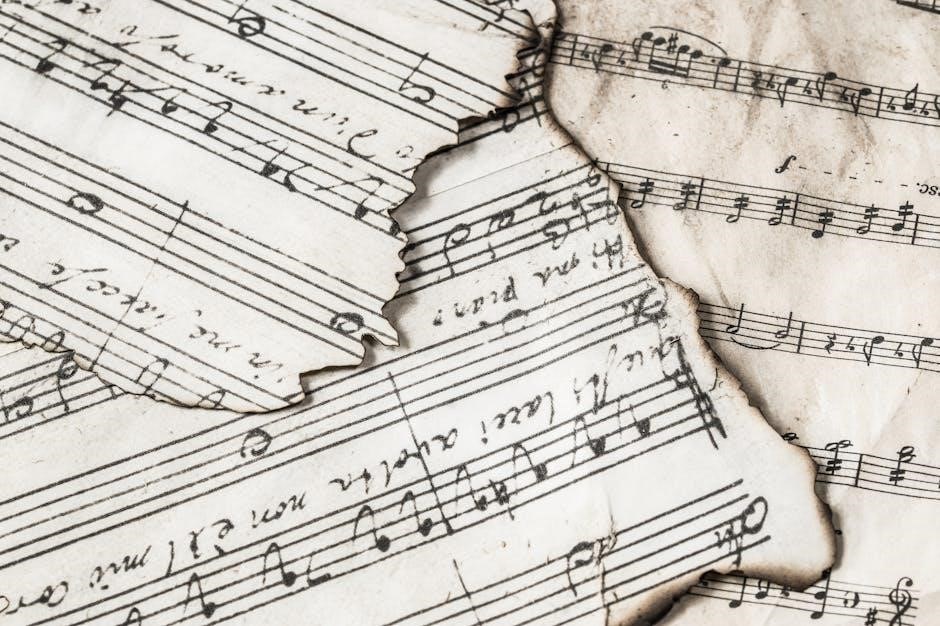Ludwig van Beethoven’s Pathetique Sonata is a monumental work in classical music, showcasing his emotional depth and compositional genius. The sonata, Op. 13, is divided into three movements, with the second movement, Adagio cantabile, being particularly renowned for its haunting beauty and expressive melody. This movement has become a favorite among pianists and music enthusiasts, with its sheet music widely available in PDF formats for easy access and practice.
Overview of the Sonata and Its Movements
Beethoven’s Pathetique Sonata (Op. 13) is a three-movement piano sonata composed in 1798. The first movement, in C minor, is marked by dramatic intensity, while the second movement, in A-flat major, is a lyrical Adagio cantabile. The third movement returns to C minor, featuring a lively rondo. This sonata is celebrated for its emotional depth and technical challenges, making it a cornerstone of classical piano repertoire. Its second movement, with its soaring melody, is particularly cherished and frequently performed. The sonata’s enduring popularity stems from its ability to evoke profound emotion through its contrasting moods and intricate composition.
Historical Significance of the Pathetique Sonata
Beethoven’s Pathetique Sonata holds a pivotal place in classical music history, marking a transition from the Classical to the Romantic era. Composed in 1798, it reflects Beethoven’s growing expressive freedom and emotional intensity. The sonata was dedicated to Prince Karl von Lichnowsky, a key patron, and its dramatic contrasts and personal depth resonated deeply with audiences. The second movement, with its hauntingly beautiful melody, became an iconic representation of Beethoven’s ability to convey profound emotion through music. This sonata solidified Beethoven’s reputation as a visionary composer, influencing generations of musicians and remaining a cornerstone of piano repertoire to this day.

Structure of the Second Movement
The second movement of Beethoven’s Pathetique Sonata is in A-flat major, with a 2/4 time signature, featuring a lyrical and emotionally resonate Adagio cantabile melody that captivates listeners with its expressive depth.
Musical Key and Tempo of the Second Movement
The second movement of Beethoven’s Pathetique Sonata is composed in the key of A-flat major, with a time signature of 2/4. The tempo is marked as Adagio cantabile, creating a serene and lyrical atmosphere. This key choice allows for rich harmonic expression, while the moderate tempo provides a sense of flowing elegance. The Adagio cantabile marking emphasizes a singing, melodic quality, making the movement emotionally resonant. Beethoven’s use of A-flat major and this tempo underscores the movement’s expressive depth, making it a cornerstone of his expressive pianistic writing.
Adagio Cantabile: The Emotional Core of the Movement
The Adagio cantabile of Beethoven’s Pathetique Sonata is a masterpiece of emotional depth, characterized by its lyrical and expressive melody. The term “cantabile” highlights the singing quality of the line, while the Adagio tempo allows for a contemplative and heartfelt performance. This movement serves as the emotional heart of the sonata, showcasing Beethoven’s ability to convey profound feeling through music. Its beautiful, flowing phrases and harmonic richness make it a favorite among pianists and listeners alike, capturing the essence of Beethoven’s romantic spirit and technical brilliance in a single, unforgettable movement.

Sheet Music Availability and Sources
Beethoven’s Pathetique Sonata sheet music is widely available online, with free PDF downloads from platforms like Mutopia Project and IMSLP. These sources offer high-quality, printable scores.
Free PDF Downloads from Mutopia Project and IMSLP
Free PDF downloads of Beethoven’s Pathetique Sonata are readily available on platforms like the Mutopia Project and IMSLP. These websites offer high-quality, downloadable sheet music, perfect for pianists of all levels. The Mutopia Project provides arrangements of the second movement in its original key, while IMSLP features a wide range of versions, including transpositions and simplified editions. Both platforms ensure that the scores are accurately typeset and free for personal use. Users can easily search for “Beethoven Pathetique Sonata” on these sites to access the PDFs instantly. MIDI files are also available for practice and listening purposes.
Paid and Arranged Versions for Different Skill Levels
For those seeking tailored arrangements, paid versions of Beethoven’s Pathetique Sonata are available on platforms like Sheet Music Plus and Music-Scores. These include simplified editions for beginners, such as Scott Powell’s easy piano arrangement, and more complex versions for advanced players. Music-Scores offers a unique arrangement by Anne Christopherson, priced at $5.95, suitable for intermediate to expert pianists. Additionally, DiaMand Creations provides instrumental solo sheet music for those looking for professional-level arrangements. These paid versions ensure high-quality sheet music, often with additional features like MP3 guides and dynamic markings, catering to diverse skill levels and performance needs.

Popular Arrangements and Transpositions
Transposition to C Major for Simplified Learning
The Pathetique Sonata’s second movement is often transposed to C Major, simplifying the key signature for easier learning while preserving the emotional essence of Beethoven’s original composition.
The Pathetique Sonata’s second movement is frequently transposed to C Major to simplify the key signature, making it more accessible for beginners and intermediate pianists. This arrangement retains the emotional depth of Beethoven’s original composition while reducing technical complexity. The transposed version is widely available as free PDF sheet music on platforms like the Mutopia Project and IMSLP. It is particularly beneficial for those who find the original key of A-flat major challenging. This adaptation ensures that the beauty and expressiveness of the movement remain intact, allowing learners to focus on musicality without being overwhelmed by intricate fingerings.
Easy Piano Arrangements for Beginners
Easy piano arrangements of Beethoven’s Pathetique Sonata’s second movement are ideal for beginners, offering a simplified version of the iconic piece. These arrangements retain the emotional essence while reducing technical complexity, making it accessible for learners. The melody and harmony are preserved in a more straightforward format, allowing pianists to focus on expression and phrasing. Many platforms, such as the Mutopia Project and IMSLP, provide free PDF downloads of these arrangements. They are perfect for those seeking to connect with Beethoven’s genius without the challenges of the original composition, fostering a deeper appreciation and mastery of classical music.

Learning and Practicing the Second Movement
Mastering the second movement of Beethoven’s Pathetique Sonata requires dedicated practice and attention to expressive phrasing. Utilize online tutorials and resources to guide your learning journey, ensuring a balance between technical precision and emotional depth.
Practice Tutorials and Online Resources
Learning the second movement of Beethoven’s Pathetique Sonata is made easier with numerous online resources and practice tutorials. Websites like Mutopia Project and IMSLP offer free sheet music in PDF format, while platforms such as Music-Scores provide arranged versions for varying skill levels. Additionally, video guides and piano tutorials on YouTube offer step-by-step instruction, helping pianists master the piece’s emotional depth and technical challenges. Many resources include MP3 files for listening and learning, ensuring a comprehensive approach to practice. These tools cater to both beginners and advanced players, making the learning process accessible and engaging.
Video Guides and Piano Tutorials
Video guides and piano tutorials are invaluable resources for mastering the second movement of Beethoven’s Pathetique Sonata. Platforms like YouTube and Music-Scores offer detailed lessons, breaking down the piece into manageable sections. Many tutorials provide insights into Beethoven’s expressive intent, helping pianists capture the emotional depth of the Adagio cantabile. Channels such as Piano Lessons On The Web and HDpiano feature step-by-step instruction, catering to both beginners and advanced players. These videos often include sheet music overlays,practice tips, and performance demonstrations, making them essential tools for learning and refining the movement.

Instrumental Solo and Ensemble Adaptations

Beethoven’s Pathetique Sonata’s second movement is adapted for various instruments, including string quartets and ensembles, preserving its emotional depth while offering fresh interpretations of the iconic melody.
String Quartet Arrangements
Beethoven’s Pathetique Sonata’s second movement has been beautifully adapted for string quartets, maintaining the emotional depth of the original while offering a fresh, ensemble perspective. Arrangers like Ken Moyer have crafted versions that preserve the Adagio cantabile’s haunting melody, blending it seamlessly with the harmonic richness of string instruments. These arrangements are particularly popular among chamber music enthusiasts, as they highlight the piece’s lyrical qualities and textural possibilities. The string quartet versions remain faithful to Beethoven’s intent while introducing new dynamics and interplay between the instruments, making them a delightful addition to any repertoire.
Other Instrumental Versions and Collaborations
Beethoven’s Pathetique Sonata’s second movement has inspired a variety of instrumental adaptations beyond the piano and string quartet. Arrangements for bass, such as Ken Moyer’s rendition, offer a unique perspective on the melody. Additionally, collaborations with other instrumental ensembles have emerged, blending the piece’s emotional depth with diverse timbres. These adaptations, available in formats like MIDI and PDF, showcase the universality of Beethoven’s composition. Collaborative arrangements by artists like MerryMandarin and veeroonaa further highlight the movement’s adaptability, providing fresh interpretations while preserving its original essence. Such versions allow musicians to explore the piece in innovative and collaborative ways, expanding its reach and appeal.

Downloads and Printing Options
Beethoven’s Pathetique Sonata’s second movement is available as PDF and MIDI files for easy download. Free sheet music can be accessed via Mutopia Project and IMSLP, with additional options requiring membership on platforms like Music-Scores for premium content.
PDF and MIDI Formats for Easy Access
Beethoven’s Pathetique Sonata’s second movement is widely available in PDF and MIDI formats, ensuring easy access for pianists. Websites like Mutopia Project and IMSLP offer free downloads, while platforms such as Music-Scores provide premium arrangements. MIDI files allow for playback and practice, helping musicians master the piece. The PDF sheets are often transposed into simpler keys, such as C major, to accommodate learners. Additionally, platforms like Sheet Music Plus offer both free and paid versions, catering to diverse skill levels. These formats make the iconic Adagio cantabile accessible to everyone, fostering practice and appreciation of Beethoven’s masterpiece.
Membership Benefits for Music-Scores and Other Platforms
Membership on platforms like Music-Scores offers exclusive benefits for accessing Beethoven’s Pathetique Sonata. Subscribers can download MP3 files for a clearer understanding of the piece, while Platinum Members can request custom transpositions. Members also enjoy unlimited access to sheet music, including rare and arranged versions. Discounts on purchases and priority customer support are additional perks. These benefits enhance the learning and performance experience, making it easier for pianists to master the second movement of the Pathetique Sonata. Platforms like IMSLP and Mutopia Project further complement these resources with free and adaptable sheet music options.

Cultural and Artistic Impact
Beethoven’s Pathetique Sonata has profoundly shaped classical music education, inspired modern composers, and remains a cornerstone of Romantic music, widely influencing contemporary works and enduring in popularity.
The Second Movement in Popular Culture
Beethoven’s Pathetique Sonata’s second movement has transcended classical circles, featuring in films, advertisements, and television shows. Its emotional depth resonates universally, making it a popular choice for soundtracks. The movement’s melodic simplicity and expressive qualities have also inspired numerous arrangements for various instruments and ensembles, further expanding its reach. In modern music, it has been sampled and reimagined in genres like electronic and pop, introducing it to new audiences. Additionally, its presence in educational materials and piano tutorials highlights its significance in music education, ensuring its cultural relevance endures across generations and artistic mediums.
Beethoven’s Legacy in Modern Music
Beethoven’s Pathetique Sonata, particularly its second movement, has left an indelible mark on modern music. Composers and artists across genres draw inspiration from its emotional depth and structural innovation. The movement’s melodic motifs and harmonic progressions are frequently referenced in contemporary works, from classical reinterpretations to electronic and pop music. Beethoven’s ability to convey intense emotion through music has influenced countless musicians, ensuring his legacy endures. His works remain a cornerstone of classical music education, with sheet music like the Pathetique Sonata continuing to inspire new generations of pianists and composers.

Additional Resources and Tools
Explore MP3 files and audio guides for deeper understanding, alongside sheet music from retailers like Sheet Music Plus. Utilize video tutorials and practice tools to enhance your learning experience.
MP3 Files and Audio Guides
Enhance your learning experience with MP3 files and audio guides available for the Pathetique Sonata. These resources provide a note-for-note representation of the sheet music, capturing dynamics and ornaments. Members of platforms like Music-Scores can access these files for free, offering a clear auditory reference. Additionally, YouTube and other platforms host practice videos and audio guides, breaking down the second movement into manageable sections. These tools are invaluable for pianists aiming to master Beethoven’s emotional and technically demanding composition, ensuring a deeper understanding of tempo, phrasing, and expressiveness.
Sheet Music Plus and Other Retail Options
For those seeking high-quality sheet music, Sheet Music Plus offers a wide range of arrangements of Beethoven’s Pathetique Sonata, including the beloved second movement. This platform provides options for different skill levels, ensuring accessibility for both beginners and advanced pianists. Additionally, other retail options like Music-Scores and specialized music stores offer various editions, often featuring expert annotations and clear typesetting. These resources are ideal for musicians seeking precise and reliable sheet music, supporting their practice and performance of this iconic piece.
Beethoven’s Pathetique Sonata’s second movement remains a timeless masterpiece, offering profound emotional depth and accessibility through its widely available sheet music, inspiring continued exploration and appreciation.
Final Thoughts on the Pathetique Sonata’s Second Movement
The second movement of Beethoven’s Pathetique Sonata is a masterpiece of emotional expression, with its Adagio cantabile melody transcending time. Its availability in PDF formats from sources like Mutopia Project and IMSLP ensures accessibility for pianists of all levels. The movement’s simplicity in structure, despite its depth, makes it a favorite for both performance and study. This piece not only reflects Beethoven’s genius but also continues to inspire musicians and composers, solidifying its place as a cornerstone of classical music repertoire. Its enduring popularity is a testament to its universal appeal and emotional resonance.
Encouragement for Further Exploration and Practice
Exploring Beethoven’s Pathetique Sonata’s second movement is a rewarding journey for pianists. Embrace the emotional depth and technical challenges it offers. Start with simplified arrangements to build confidence, then gradually tackle the original work. Utilize online tutorials and practice guides to refine your technique. Remember, mastering this piece is a process that requires patience and dedication. As you delve deeper, you’ll discover the richness of Beethoven’s composition and the lasting impact it has on music. Keep practicing, and let the beauty of this movement inspire your musical growth and appreciation for classical masterpieces.